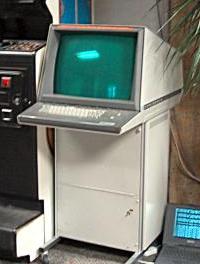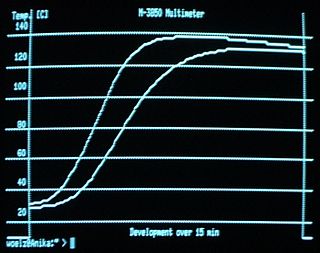
The VT100 is a video terminal, introduced in August 1978 by Digital Equipment Corporation (DEC). It was one of the first terminals to support ANSI escape codes for cursor control and other tasks, and added a number of extended codes for special features like controlling the status lights on the keyboard. This led to rapid uptake of the ANSI standard, becoming the de facto standard for terminal emulators.
RT-11 is a discontinued small, single-user real-time operating system for the Digital Equipment Corporation PDP-11 family of 16-bit computers. RT-11 was first implemented in 1970 and was widely used for real-time systems, process control, and data acquisition across the full line of PDP-11 computers.

A computer terminal is an electronic or electromechanical hardware device that is used for entering data into, and displaying or printing data from, a computer or a computing system. The teletype was an example of an early day hardcopy terminal, and predated the use of a computer screen by decades.

The VT220 is an ANSI standard computer terminal introduced by Digital Equipment Corporation (DEC) in 1983. The VT240 added monochrome ReGIS vector graphics support to the base model, while the VT241 did the same in color. The 200 series replaced the successful VT100 series, providing more functionality in a much smaller unit with a much smaller and lighter keyboard. Among its major upgrades was a number of international character sets, as well as the ability to define new character sets.

The Tektronix 4010 series was a family of text and graphics computer terminals based on the company's storage tube technology. There were several members of the family introduced through the 1970s, the best known being the 11-inch 4010 and 19-inch 4014, along with the less popular 25-inch 4016. They were widely used in the CAD market in the 1970s and early 1980s.

Storage tubes are a class of cathode-ray tubes (CRTs) that are designed to hold an image for a long period of time, typically as long as power is supplied to the tube.

In computing, xterm is the standard terminal emulator for the X Window System. A user can have many different invocations of xterm running at once on the same display, each of which provides independent input/output for the process running in it.

The VT420 was an ANSI standard computer terminal introduced in 1990 by Digital Equipment Corporation (DEC). The 420 was the only model in the 400 series, replacing the VT320. There were no color or graphics-capable 400 series terminals; the VT340 remained in production for those requiring ReGIS and Sixel graphics and color support. The entire lineup of VT300s and VT420 was eventually replaced by the relatively unknown VT500 series starting in 1993.
NCSA Telnet is an implementation of the Telnet protocol created at the University of Illinois at Urbana-Champaign National Center for Supercomputing Applications in 1986 and continuously developed until 1995. The initial implementation ran under Mac OS and Microsoft MS-DOS and provided basic DEC VT102 terminal emulation as well as support for multiple simultaneous connections and an internal FTP server. At the time, NCSA Telnet was the first implementation of telnet for the Macintosh or a PC that provided the ability to connect to multiple hosts simultaneously.

The Tektronix 4050 was a series of three computer graphics microcomputers produced by Tektronix in the late 1970s through the early 1980s. The display technology was similar to the Tektronix 4010 terminal, using a storage tube display to avoid the need for video RAM. They were all-in-one designs with the display, keyboard, CPU and DC300 tape drive in a single desktop case. They also included a GPIB parallel bus interface for controlling lab and test equipment as well as connecting to external peripherals. A simple operating system and BASIC interpreter were included in ROM.

Sixel, short for "six pixels", is a bitmap graphics format supported by terminals and printers from DEC. It consists of a pattern six pixels high and one wide, resulting in 64 possible patterns. Each possible pattern is assigned an ASCII character, making the sixels easy to transmit on 7-bit serial links.
The VT520 is an ANSI standard computer terminal introduced by Digital Equipment Corporation (DEC) in 1993 and 1994. The VT520 is multi-session monochrome text terminal. The VT525 added color support, while the VT510 was a single-session, text-only version with a built-in monitor. The VT525 appears to be the most popular model in the series.
GNU plotutils is a set of free software command-line tools and software libraries for generating 2D plot graphics based on data sets. It is used in projects such as PSPP and UMLgraph, and in many areas of academic research, and is included in many Linux distributions such as Debian and cygwin. Windows and Mac OS X versions are also available. The library provides bindings for the C and C++ languages. Its stand alone command-line tools can generate graphs and perform numerical calculation of spline curves and systems of ordinary differential equations. Plotutils is a GNU package and is distributed under a free software licence, the GPL.
ReGIS, short for Remote Graphic Instruction Set, was a vector graphics markup language developed by Digital Equipment Corporation (DEC) for later models of their famous VT series of computer terminals. ReGIS supported rudimentary vector graphics consisting of lines, circular arcs, and similar shapes. Terminals supporting ReGIS generally allowed graphics and text to be mixed on-screen, which made construction of graphs and charts relatively easy.

The VT320 was an ANSI standard computer terminal introduced by Digital Equipment Corporation (DEC) in 1987. The VT320 was the text-only version, while the VT330 added monochrome ReGIS, Sixel and Tektronix 4010 graphics, and the VT340 added color.

Waveform graphics was a simple vector graphics system introduced by Digital Equipment Corporation (DEC) on the VT55 and VT105 terminals in the mid-1970s. It was used to produce graphics output from mainframes and minicomputers. DEC used the term "waveform graphics" to refer specifically to the hardware, but it was used more generally to describe the whole system.
Tellagraf is an early software package designed to allow end-users to "turn out full color, professional quality charts" with initial results displayed on a screen, modified as needed, and then "a final 'hard-copy' can be made .. or made into 35mm color transparencies for projection onto a screen."
In Unix, graph is a command-line utility used to draw plots from tabular data.










